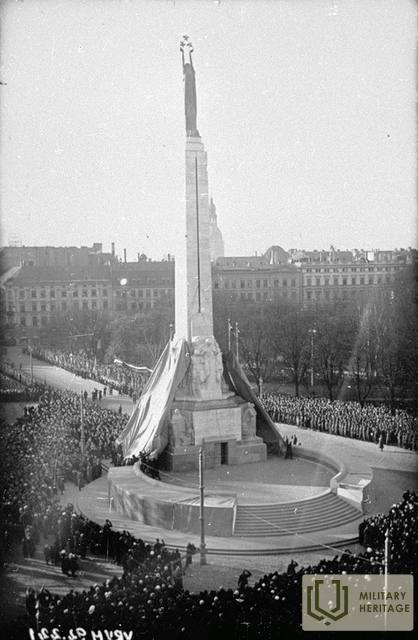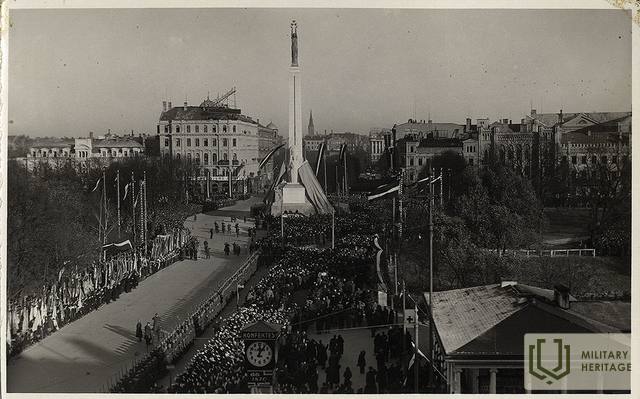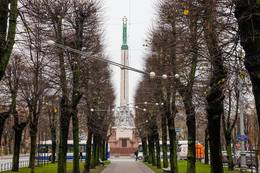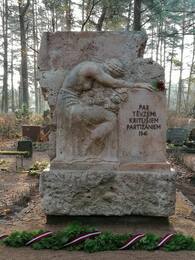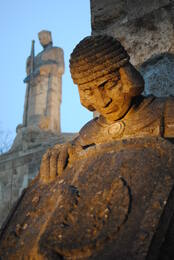Kārlis Zāle and the Freedom Monument
The narrator describes Kārlis Zali as a personality who created the most famous works of Latvian art. The description is dedicated to the commemoration of the hall in 1942 (the year of K. Hall's death). The memories have been chosen to describe K. Zāle's works based on the author's personal qualities and perception of the world.
“(..) In the course of life and work, the personality of the Hall has developed from its inner center. The hall is one of those people with whom you could immediately feel the inner core, which is important. This core lay in his vitality. the innate forces, the legacy of the course ancestors, is the great dowry that Laima placed in the cradle of the son of Course. Nature had endowed the Hall with wasteful nature. The tireless liveliness flowed on the sculptor's floor, in every gesture, in the expressive play of features and in the language, giving everything a special freshness and juiciness. His fantasy sparkled briskly and spontaneously from the fertile vital layer. From here came all that was original and healthy primitive in the life and work of the Hall. This unspoiled stockpile of peasant forces broke through the way and overcame adversity. In creative work, it provided an opportunity to say something of our own and something new, to stand out in the first place, gaining outstanding achievements in our monumental sculpture. In this region of art, we did not have our own traditions grown in the circle of modern culture, which began to develop in the region of Latvian painting since the end of the last century. In this way, we could easily submit to the influence of the ancient cultural peoples, remaining imitators and descendants. "If this did not happen, if in a relatively short time our best sculptors could create something unique and remarkable in the field of monumental sculpture, it is due to the rustic foundation of our lives. This ancient layer is expressed by Zāle with deep and instinctive security. could grow from the roots of rustic fresh primitiveness, looking beyond the ancient wisdom and beauty of today's cultural decoration in its - I would say - barbaric splendor and grandeur ... '
"(..) We, the master said, do not have to be ashamed and run away from ourselves and the time we stand, but we must be who we are - Lat public artists. If you are an artist, show the power of your land, its blessings and beauty, show the workers in their efforts, show the mothers of the guardians of the family, the guardians of the fatherland, show it all with dignity, warm feelings and reverence for others to see who we are , and we could be respected. But if thou make thy faces perverse in thy foolish countenance, and smite the face of the peasants and of the laborers with mud, and make them like crippled beasts, and show them as slaves and criminals? . It doesn't hurt to throw away your brushes and go digging ditches or do some other useful work. How can others respect you if you can't respect yourself? Being an artist does not mean slipping through life and random details, but it means looking for the core and the nucleus in nature and in people. The dilettante sticks to random details and does not see the main thing, but the other dilettante jokes with the form and rejoices as if about happy coincidences. If I spit, my spit will sometimes erupt with unknown twists and drops, but can it be approached by a serious artist for his art? This is done only by dilettante pawns, who show off their nonsense, but not by serious painters. Gentleman and dilettante - those words were bitter and despicable in the mouth of the Hall. The sculptor also did not respect light improvisation and empty excitement in art. Especially in the last stages of his life, Hall increasingly emphasized the importance of knowledge and true ability, skills and mastery. He highly respected the traditions of academic art. At the same time, at the meeting of the Brothers' Cemetery Committee, the sculptor refuted the academician F.'s objections that the horse floors he created were not in the right proportions. The hall then had the ring brought in and measured that everything was in line with recognized norms. F. then felt purely awkward. I remember that when showing the photos from the works of the masters of the academic field in the Luxembourg Museum, the Hall was happy: “What knowledge and skill here! It is immediately clear what the master wanted to achieve. There are proportions, understanding of the formation of forms, a sense of beauty. Such works will still retain their value and will not get tired. But with us, some good ones imagine in their incompetence and unpreparedness that we make great works of art. "(..)"
“(..) On the one hand, Zāle paid attention to serious studies of form, understanding of movements and anatomical structure, but on the other hand, he focused on composition. For students who have already imagined we are ready-made artists who are allowed to do as they please, Zāle simply told them not to waste time here at the academy. The profession of sculpture must be studied at the academy, knowledge and art must be acquired. It is very good to do what everyone likes and what comes to mind at home. With great enthusiasm, Professor Zāle was able to approach the students without suppressing their individual perception, but finding out what to do and how to approach their task. For the first time, many people opened their eyes and the favorable results could be seen in an exhibition of students' works in a short time. The hall delved into the meaning of the composition, the structure of forms, the movement of figures, expression and characterization. When the student had realized what to look for in a certain essay, the study of strict natural forms took on a completely different meaning. In this way he taught the students to consciously control their formation, but not to make no sense to simply copy the visibility of nature (...) ”
"(..) He took part in the design competition for the Freedom Monument in 1924 and 1925. In 1925, the Cabinet of Ministers decided that the Freedom Monument should be erected after the Hall, but this decision was not implemented. There was a lot of intrigue and noise going on around these years, but there was no definite positive outcome. However, the competition, like the work of the Brethren's Cemetery, played an important role in the development of the Hall. He gained considerable experience, got a lot to consider and think about, to find out his ideas, which could later be put into practice. The master and some of his closest friends had their own meeting place in the city • - at Madernieka, Brīvības Street 13. Here, collaborators also gathered, as this was the home of this artists' association. There, the events and artistic issues of the day were discussed in detail; wrote or discussed some good articles. There was a "headquarters" here, where the situation was discussed during the monument competition, rejoicing in success and flirting with failures. The issue of the monument was abandoned in 1930. The last competition for the design of the monument took place in 1930, when the hall won the first prize. At that time, a high barracks - a workshop with bright windows - rose on the monument's square. The chisels of many stonemasons and craftsmen were knocked both on the ground and on the platforms. alti, tearing the solid granite mass. It was like a strange country of fairy tales, where the creator's will to immerse and remain in matter was seen in the spirit. Sunlight shone in the armchair of the spacious rooms, and the white floors of the giants gleamed in it, everyone waiting for the moment of their fulfillment in a quiet solemnity. There were scattered blocks of stone all around with arranged parts: arms, waist, heads, a true membrane di- siecta - as the Latin poet says. These impressions remained indelible in the workshop. The Freedom Monument was made. In the meantime, the hall had acquired a house on Avotu Street. Its income was to support the existence of the master and his family in order to be able to live and work independently in the future, as the artist's intentions were rich and extensive (...).
“(..) The past and the present are included in the Freedom Monument as one indivisible song in the sounds of heroism. In the great breath it expresses the whole life of the people: work, search for the spirit, family, military power; Lāčplēsi - a performer of the savage forces, a singer-vaideloti; the shackles of slavery and the image of Freedom with shining three stars are also opened by historical scenes. The wonderful light of the legend shines everywhere. Many other works of the Hall in recent years tell the same. in the images of reality here the master seeks the essence and elevates the reality itself to the solemn and simple beauty of the legend (..) ”
newspaper “Latvian Monthly”, no. 5. 1942. The title of the article “Kārlis Zāle”
Related timeline
Related objects
The Freedom Monument in Riga
It is located in the center of Riga, on Brīvības Square.
The Freedom Monument is one of the most outstanding monuments of Latvian history, architecture and art. It was built according to the project of Kārļis Zaales based on public donations. Opened in 1935 as a symbol of Latvian people's freedom and love of the fatherland. Together with the Riga Brothers' Tomb ensemble, it belongs to the most valuable examples of monumental architecture and sculpture.
The Freedom Monument expresses the ethical and aesthetic values of Latvian culture. The symbols reflect the philosophical nature of freedom and the Latvian nation's historical ideas about the stages of the struggle for independence. Indicates the embodiment of physical and mental strength. The heroic language tells about the Latvian nation as a self-reliant, active maker of history and a determiner of its own destiny.
In its place, there was originally a monument to the Russian Tsar Peter I. In World War 1, it was dismantled to be transported by ship to Petrograd. The ship was torpedoed by a German submarine and sank off the island of Worms in the Estonian territory. The Soviet occupation regime planned to demolish the Freedom Monument several times, but it did not materialize.
Nowadays, you can see one of the symbols of Latvia and observe the traditions of the army honor guard.
Monument "Grieving mother" at Inčukalns Cemetery of Honour
Located: Inčukalns district, Inčukalns, Miera street, Inčukalns cemetery.
The monument was unveiled on July 16, 1944. The monument was discovered after the death of K. Zāle. Inscription: On the partisans who fell to the Fatherland in 1941 (restored). The monument was restored on November 5, 2020. The monument was restored with the support of Inčukalns County Council. Restorer artist Igor Dobichin.
Events: “1940. On June 17, Latvia was occupied by the USSR. On June 14, 1941, deportations took place. On June 22, 1941, Germany attacked the USSR and parts of the Wehrmacht entered Latvia. The Red Army and its supporters withdrew. In many places in Latvia - including Ragana, Sēja and Inčukalns - former guards and patriotic young people organized to protect their homes and hurry to expel the Soviet occupiers. When the flag of the Free State of Latvia was hoisted again on July 1, 1941 in the sown parish "Ziediņi", special units of the Red Army at the Northern Cemetery shot the owner of this house - 39-year-old Elza Viša, but on the border of Sēja and Krimulda parish her mother - 64-year-old Elza Martinovu. The residents of the area caused even more hatred and outrage, and they began to gather in the popular resistance movement and form self-defense units, which were also called the first partisans (the leader of the Inčukalns group was Maksis Cālītis). Soldiers and officers who had escaped from the Litene military camp or were released from the so-called Latvian territorial corps also joined the fighters of the county. An armed clash with the Reds took place a few days later, on July 4, seven soldiers and the son of Ragana's pharmacist Pēteris Prašķēvičs fell. In addition, Jānis Porietis, a 17-year-old student of the Rēzekne Teachers' Institute, was injured and captured in the Battle of Ragana and tortured, shot and buried near Straupe.
Here in Inčukalns, a common grave of the brothers was excavated, to which coffins made of white unplaned boards were brought in eight horse-drawn carriages to lay the fallen heroes in their homeland. A few months later, already during the German occupation, a monument was erected in the cemetery by Kārlis Zāle (from 1939 until the end of his life on February 19, 1942, due to a serious illness, the genius Latvian sculptor chose Inčukalns as his residence) - the image of a mourning mother over a rose lap. In the 1950s, local Communist Party activists blew up the monument. The monument was damaged and stagnant until the Awakening, when in the late 80's more and more people became interested and talked about the events of July 4, 1941 and called for the restoration of the monument to Charles Hall. Such a demand was made at the meeting of people and power convened at Inčukalns Primary School on September 8, 1988, which was attended not only by Inčukalns residents, but also by residents of nearby parishes, as well as members of the Environmental Protection Club and LNNK from Riga.
In The people of Inčukalns - Teodors Ildens, Arvīds Blaus, Pēteris Vorfolomējevs -… and many other patriotic people actively participated in the restoration of the monument. On July 4, 1989, in a solemn ceremony, the reborn noble and sad tabby was consecrated by Pastor Vaira Bitena. ”
Brothers' Cemetery in Riga
Riga Brothers’ Cemetery is located in the northern district of Riga. The cemetery extends over an area of 9 ha and is the most outstanding and significant memorial ensemble in Latvia dedicated to the fallen Latvian soldiers. About 3,000 soldiers are buried here. The Brothers’ Cemetery was created during World War I after the first three Latvian Riflemen, who fell in Tīreļpurvs in the battle against the German Army, were buried here. Later Latvian soldiers who had died in other battles and wars would also be buried in the Brothers’ Cemetery. The memorial is based on the design of the sculptor Kārlis Zāle, and is the first memorial ensemble in Europe with such landscape, architecture and sculptural value. It uses elements typical to the Latvian landscape, traditional farmsteads, Latvian folklore and history that praise the characteristics of soldiers and tell the story of the way of the soldier. The memorial was unveiled in 1936 and it has three parts: ‘The Road of Though’ which is a 250 m long alley, ‘Terrace of Heroes’ with the Altar of the Sacred Flame and ensemble the Sacred Oak Grove, and the burial ground with the Latvian wall and a memorial of a mother with her fallen sons.




